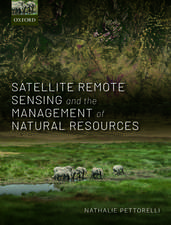Design and Analysis of Long-term Ecological Monitoring Studies
Editat de Robert A. Gitzen, Joshua J. Millspaugh, Andrew B. Cooper, Daniel S. Lichten Limba Engleză Paperback – 6 iun 2012
Preț: 566.57 lei
Preț vechi: 636.59 lei
-11% Nou
Puncte Express: 850
Preț estimativ în valută:
108.41€ • 113.50$ • 89.70£
108.41€ • 113.50$ • 89.70£
Carte tipărită la comandă
Livrare economică 05-19 aprilie
Preluare comenzi: 021 569.72.76
Specificații
ISBN-13: 9780521139298
ISBN-10: 0521139295
Pagini: 590
Ilustrații: 84 b/w illus. 4 colour illus. 42 tables
Dimensiuni: 174 x 247 x 26 mm
Greutate: 1.13 kg
Ediția:New.
Editura: Cambridge University Press
Colecția Cambridge University Press
Locul publicării:Cambridge, United Kingdom
ISBN-10: 0521139295
Pagini: 590
Ilustrații: 84 b/w illus. 4 colour illus. 42 tables
Dimensiuni: 174 x 247 x 26 mm
Greutate: 1.13 kg
Ediția:New.
Editura: Cambridge University Press
Colecția Cambridge University Press
Locul publicării:Cambridge, United Kingdom
Cuprins
List of contributors; Foreword; Preface; Acknowledgements; Part I. Overview: 1. Ecological monitoring: the heart of the matter Robert A. Gitzen and Joshua J. Millspaugh; 2. An overview of statistical considerations in long-term monitoring Joel H. Reynolds; 3. Monitoring (that) matters Douglas H. Johnson; 4. Maximizing the utility of monitoring to the adaptive management of natural resources William L. Kendall and Clinton T. Moore; Part II. Survey Design: 5. Spatial sampling designs for long-term ecological monitoring Trent McDonald; 6. Spatially balanced survey designs for natural resources Anthony R. Olsen, Thomas M. Kincaid and Quinn Payton; 7. The role of monitoring design in detecting trend in long-term ecological monitoring studies N. Scott Urquhart; 8. Estimating variance components and related parameters when planning long-term monitoring programs John R. Skalski; 9. Variance components estimation for continuous and discrete data, with emphasis on cross-classified sampling designs Brian R. Gray; 10. Simulating future uncertainty to guide the selection of survey designs for long-term monitoring Steven L. Garman, E. William Schweiger and Daniel J. Manier; Part III. Data Analysis: 11. Analysis options for estimating status and trends in long-term monitoring Jonathan Bart and Hawthorne L. Beyer; 12. Analytical options for estimating ecological thresholds - statistical considerations Song S. Qian; 13. The treatment of missing data in long-term monitoring programs Douglas H. Johnson and Michael B. Soma; 14. Survey analysis in natural resource monitoring programs with a focus on cumulative distribution functions Thomas M. Kincaid and Anthony R. Olsen; 15. Structural equation modeling and the analysis of long-term monitoring data James B. Grace, Jon E. Keeley, Darren J. Johnson and Kenneth A. Bollen; Part IV. Advanced Issues and Applications: 16. GRTS and graphs: monitoring natural resources in urban landscapes Todd R. Lookingbill, John Paul Schmit and Shawn L. Carter; 17. Incorporating predicted species distribution in adaptive and conventional sampling designs David R. Smith, Lei Yuancai, Christopher A. Walter and John A. Young; 18. Study design and analysis options for demographic and species occurrence dynamics Darryl I. MacKenzie; 19. Dealing with incomplete and variable detectability in multi-year, multi-site monitoring of ecological populations Sarah J. Converse and J. Andrew Royle; 20. Optimal spatio-temporal monitoring designs for characterizing population trends Mevin B. Hooten, Beth E. Ross and Christopher K. Wikle; 21. Use of citizen-science monitoring for pattern discovery and biological inference Wesley M. Hochachka, Daniel Fink and Benjamin Zuckerberg; Part V. Conclusion: 22. Institutionalizing an effective long-term monitoring program in the US National Park Service Steven G. Fancy and Robert E. Bennetts; 23. Choosing among long-term ecological monitoring programs and knowing when to stop Hugh P. Possingham, Richard A. Fuller and Liana N. Joseph; References; Index.
Recenzii
'… a valuable reference for professionals seeking the latest design and analysis techniques for long-term ecological monitoring.' The Quarterly Review of Biology
'If you do monitoring, you need a copy of this book. It is that good.' Philip M. Dixon, Ecology
'If you do monitoring, you need a copy of this book. It is that good.' Philip M. Dixon, Ecology
Descriere
Presenting fundamental and advanced statistical tools and issues relevant to long-term ecological monitoring, this volume will enable a better understanding of how to maximize the effectiveness of monitoring. It features contributions from a diverse group of experts practised at teaching ideas and methods to natural resource managers, scientists and students.











